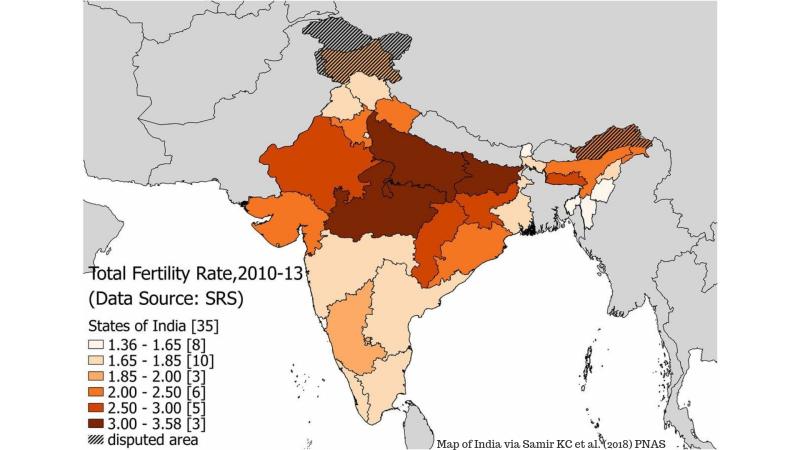
“It’s difficult to make predictions, especially about the future”, goes a saying, although it is contested as to who said this. The essence of this saying is nowhere more true than in the field of population projections. For example, naively extrapolating the past rate of world population growth into the future starts to give absurd results very quickly. Yet, this has not deterred people from trying to project not only population growth but a host of associated social and economic parameters into the future.
Back in the 19th century, Thomas Malthus, an English scholar in economy and demography, argued that population increases exponentially, while food production can only grow linearly. It meant that eventually there would be too many hungry mouths to feed that our food production cannot match. Ultimately, the world would tend towards a ‘Malthusian catastrophe’. However, an increasing population also has its benefits. It can lead to growth in the economy due to the change in the age structure of the population. This positive outcome is called the ‘demographic dividend’.
By 2025, India’s population is expected to reach 1.5 billion. Will this increase produce a ‘demographic dividend’ or lead to a ‘Malthusian catastrophe’? Different methods for predicting India’s future population give radically different results. Now, researchers at the Shanghai University, China and the International Institute for Applied Systems Analysis, Austria, have developed a novel model that takes many other characteristics of the population into account, compared to other models, to make demographic projections.
Conventional models for population projection use the national age and sex distribution for their estimates. But, the population of a country does not consist of identical individuals producing the same number of offspring. The authors of the present study, published in the Proceedings of the National Academy of Sciences (PNAS), argue that such models suffer from two types of difficulties. They do not consider the heterogeneity of the population and do not take into account all possible factors that influence fertility rates.
In a vast country like India, fertility rates show significant regional differences. For instance, in the 1990s, the fertility rate in Kerala was 1.8 per woman while it was 5.1 in Uttar Pradesh. Applying the same model, but at the level of each state rather than nationally, yields a substantially higher national population because the high-fertility states produce a more offspring and hence gain higher weightage over time. This raises the question of the appropriate scale at which the model should be applied.
However, even among individuals of the same age and sex, other factors determine how many offspring they are likely to produce. One such element is the education level of an individual because educated women tend to produce fewer children. Explicitly considering education levels, and its projected increase with time, results in lower projected population growth as the proportion of educated women, with lower fertility rates, increases with time. Hence, the projection model needs to recognise factors whose inclusion will help improve predictions, while not burdening it with superfluous details.
In this study, the researchers propose a multi-dimensional model that projects future trajectories of fertility, mortality and migration based on current data and past trends. Besides, to address the issue of heterogeneity, the researchers consider the urban and rural populations of each of India’s states and union territories separately.
The results of the analyses show India’s population peaking between 1.66 billion and 1.8 billion by mid-century, before declining after 2070. If education enrollment were to remain constant at today’s levels, India would still have a significant population of uneducated people. However, in the last thirty years, the proportion of adult women without school education has fallen from 70% to 46%.
If education enrollment levels continued to increase, one would expect concomitant improvements in human development and economic growth, say the researchers. They also point out that broad-based education has many benefits ranging from poverty eradication and economic growth to health and well-being to quality of institutions and even democracy.
The study provides some insights into the implications of population growth for the future of India, and also for developing other population projection models around the world.
“We have shown how different degrees of accounting for measurable heterogeneity within populations changes the way in which we see the future”, say the authors.
Similar studies on population estimations in the past have had distinctly mixed results. One of the most well known is the “Second India” study commissioned by the Ford Foundation in the 1960s to examine the social and economic consequences of a projected doubling of the Indian population from 500 million, which it was then, to 1 billion. In retrospect, projections for food production turned out to be underestimates, whereas projections on education and poverty were too optimistic.
So, what does the future hold for India? How does India compare with its neighbour China, which also has a comparably large population? The researchers note that China is about three to four decades ahead of India because of its massive investment in universal education in the 1950s. The education pyramid of India looks similar to China’s in 1980, and the projected education pyramid for India in 2050 looks similar to China’s today.
“While cultural and institutional factors may differ between the two countries, and there can be no perfect analogy, this comparison makes it look likely that India will experience similarly rapid human-capital–driven development as China has over the past three to four decades”, concludes the study.





